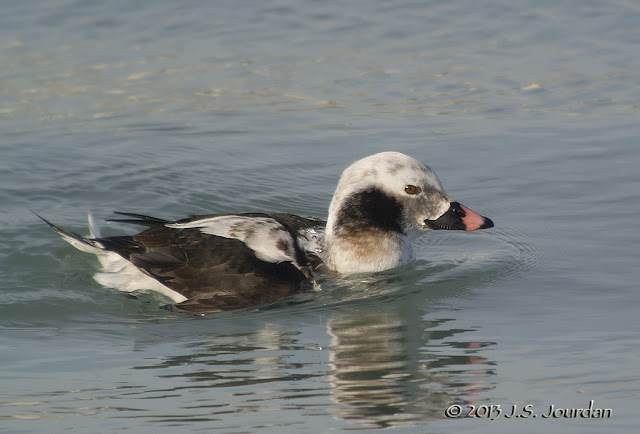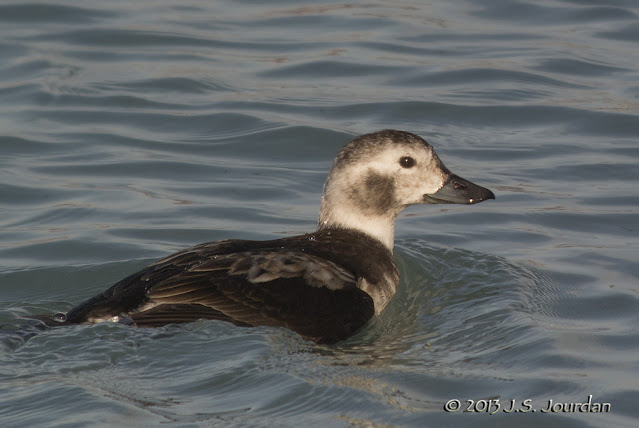Ageing Long-tailed Ducks - 27 Jan 2013
The recent cold snap did wonders for local waterway birding. The Detroit River has had enough ice to concentrate waterfowl close to shore and make for some nice counts. I decided to make a run to Port Huron, MI / Sarnia, ON to see if perhaps the Long-tailed Ducks and (possibly) scoters were concentrating at the mouth of the St. Clair River. With the sun peaking out low over the sky I thought it best to cross the Blue Water Bridge and head to Pt. Edward Lighthouse, so that I could observe (and digiscope) birds w/ the sun behind me.
Long-tailed Ducks were in abundance in the open water at the mouth of the river, while much of the rest of Lake St. Clair was ice-covered, so I had the opportunity to get some nice digiscoping from the shoreline. A large raft of ducks were floating in the middle of the channel, but enough birds were drifting along the near shore that I was able to get some nice portraits. I could even spend some time working on flight shots as the birds flew back out to the mouth of the river after drifting downstream toward the bridge. I figured it'd also be a good opportunity to polish my ID skills, so I thought I'd spend some time trying to see if I could age some of the birds.
Oh, what did I get myself into?
It turns out that differentiating males from females is relatively straightforward, even in the juvenile birds. Look for the birds w/ a bright pink band on the bill and you have a male. The juveniles will show some semblance of a pink wash that help distinguish them from females, which tend to have a uniform blue-gray bill.
The adult males tended to stay out in the mouth of the river and among the large raft of mostly females and juveniles. But a few made close enough passes in the water and in the air to keep me busy.
Here's a suspected juvenile male. It shows an overall brown, buffy coloration with brown crown, and pink wash across the bill. There's no evidence of white scapular feathers; instead, just light brown feathers, which is typical of juvenile birds of both sexes.
Here's another suspected juvenile male with a whiter head (less brown on the crown), and white scapular feathers, less brown on the flanks. The pink wash on the bill is evident, as well.
Now things get more interesting/complicated. This male could be a 2nd year bird / non-breeding adult. Note the bright pink bill band, but overall mottling of head, chest and scapulars. Its also lacking a long, central tail feather.
Most duck species show two molting cycles per year. Long-tailed Ducks are unique in that they undergo a third, supplemental molt late in the summer/early fall (Palmer, 1976 in Howell, 2003) that consists of replacement of head, neck and scapular feathers. A pre-alternate molt then occurs between Sep - Dec where all feathers are replaced except tail, wing and posterior underparts. Prebasic molt occurs in two parts: in April when much of the head, breast and mantle are molted; then after breeding (late July) when the rest of the feathers are molted including flight feathers. This results in the birds being unable to fly for 3 - 4 weeks.
Note: the terms 'alternate' and 'basic' plumage aspects are confusing when it comes to ducks and geese. Unlike most other bird species, where alternate refers to brightly-colored spring birds sporting their best colors for mating and basic is the dull winter plumage, in ducks the reverse is true. The winter males are, according to Pyle (2005), really in 'basic' plumage, but are sporting their brightest colors, while the more-cryptic dark brown males of spring/summer are in an alternate or eclipse plumage that occurs during the actual breeding period. So, depending on the source (European) the terms are reversed and confusing when one tries to research the earlier (and seminal) works. Reread the previous paragraph, and you'll see why I've been pulling my hair out all week - Palmer referred to the late fall molt as pre-alternate, when Pyle refers to it as prebasic. Phil Humphrey and Ken Parkes (1959) addressed these issues when they proposed the now-famous H-P System that attempts to remove 'color' from molt progressions. I would recommend at this point that anyone shaking their head should get a copy of Steve N.G. Howell's Molt in North American Birds - he describes in great detail the crazy world of molt, molt regimes, classification of molts, and everything else related to bird appearance. These issues are addressed, and he even introduces a modified H-P System to help tie all the classification regimes into something that can be agreed upon by all.
What did I get myself into?
That would indicate that the long central retrix feathers have fallen out while here on its wintering grounds and are regrowing? A number of these birds were observed in flight with missing or very short tail feathers. In the last two images below this individual appears to be missing the P9 feather on the left wing and the P6 and P3 (?) feathers on the right wing, suggesting a partial winter 'pre-alternate' molt. Pyle (2008) indicates that definitive prealternate molt begins on the non-breeding grounds and completes on the breeding grounds. Is January too early, though? Dunno.
I would love to hear from our seasoned birders here in MI / ON their thoughts on these wintering birds.
I probably did no one any favors by posting this blog, but I'm hoping that I've demonstrated that aging Long-tailed Ducks is not for the faint-hearted. Long-tailed Ducks are fascinating and beautiful birds, and we are fortunate enough here in SE Michigan to be able to see them at least a few months of the year. They have perhaps the most complex and variable molt strategy among ducks, so aging them, especially in winter is always a challenge.
References:
Howell, S.N., Molt in North American Birds, Peterson Reference Guides, 2010, Houghton-Mifflin Press.
Pyle, P., Molts and Plumages of Ducks (Anatinae), 2005, Waterbirds 28(2): 208-219.
Pyle, P., Identification Guide to North American Birds, Part II, 2008, 140-143.
Howell, M.D., Grand, J.B, Flint, P.L. Body Molt of Male Long-tailed Ducks in the Near-Shore Waters of the North Slope, Alaska, 2003, Wilson Bulletin, 115(2), 170-175.
Edison Park, St. Clair, Michigan, US
Jan 27, 2013 9:00 AM - 10:00 AM
Protocol: Stationary
Checklist Comments: Most of Lake St. Clair frozen except mouth of river under Blue Water Bridge
6 species
Canada Goose (Branta canadensis) 45
Mallard (Anas platyrhynchos) 15
Long-tailed Duck (Clangula hyemalis) 200
Bufflehead (Bucephala albeola) 2
Red-breasted Merganser (Mergus serrator) 6
Glaucous Gull (Larus hyperboreus) 2
View this checklist online at https://ebird.org/checklist/S1
This report was generated automatically by eBird v3 (https://ebird.org/home)
I would love to hear from our seasoned birders here in MI / ON their thoughts on these wintering birds.
How about the females? These birds also show a great deal of variability in their basic plumage aspect, but their uniform blue-gray bills separate them from the pink-billed males. According to Pyle (2008) the juvenile females have whitish-gray scapulars, or silver-tipped feathers that are more rounded or blunt-edged. Adult females tend to have scapular feathers that are more brown or rufous-tipped. Adult females in winter have whiter crowns, while juveniles have more extensive brown on their heads and cheeks. Most of the females I observed this day tended to have more whitish feathers on their backs, suggestive of juvenile / second year birds. A few showed more brownish scapulars, which is suggestive of adult females. Again, the problem occurs that there is great variability in head, face and scapular coloration depending on molt timing, so it may be best not try to age them.
 |
| Dark crown and scapulars - 1st winter female? |
 |
| Whitish scapulars / dk crown - 2nd winter female? |
 |
| Note variability in crown / cheek patches |
 |
| Juv female? or male? - note pinkish wash on bill |
I probably did no one any favors by posting this blog, but I'm hoping that I've demonstrated that aging Long-tailed Ducks is not for the faint-hearted. Long-tailed Ducks are fascinating and beautiful birds, and we are fortunate enough here in SE Michigan to be able to see them at least a few months of the year. They have perhaps the most complex and variable molt strategy among ducks, so aging them, especially in winter is always a challenge.
References:
Howell, S.N., Molt in North American Birds, Peterson Reference Guides, 2010, Houghton-Mifflin Press.
Pyle, P., Molts and Plumages of Ducks (Anatinae), 2005, Waterbirds 28(2): 208-219.
Pyle, P., Identification Guide to North American Birds, Part II, 2008, 140-143.
Howell, M.D., Grand, J.B, Flint, P.L. Body Molt of Male Long-tailed Ducks in the Near-Shore Waters of the North Slope, Alaska, 2003, Wilson Bulletin, 115(2), 170-175.
Edison Park, St. Clair, Michigan, US
Jan 27, 2013 9:00 AM - 10:00 AM
Protocol: Stationary
Checklist Comments: Most of Lake St. Clair frozen except mouth of river under Blue Water Bridge
6 species
Canada Goose (Branta canadensis) 45
Mallard (Anas platyrhynchos) 15
Long-tailed Duck (Clangula hyemalis) 200
Bufflehead (Bucephala albeola) 2
Red-breasted Merganser (Mergus serrator) 6
Glaucous Gull (Larus hyperboreus) 2
View this checklist online at https://ebird.org/checklist/S1
This report was generated automatically by eBird v3 (https://ebird.org/home)





































Beautiful photos of a lovely bird! Thank you for sharing them.
ReplyDeleteGorgeous photos of a lovely bird. Thank you for sharing them!
ReplyDeleteActually, you did me a big favor. I had photographed a mystery duck a few weeks ago off the Outer Banks. It was getting dark and the bird was flying off into the distance, so ID was a challenge. I was guessing it was a Long-tailed Duck, but the tail was short and the wings were mostly dark. Also, I'm from Colorado, so I'm not familiar with this species. Thanks to your photos, I was able to verify my ID as a juvenile male. Thanks!
ReplyDeleteActually, you did me a big favor. I had photographed a mystery duck a few weeks ago off the Outer Banks. It was getting dark and the bird was flying off into the distance, so ID was a challenge. I was guessing it was a Long-tailed Duck, but the tail was short and the wings were mostly dark. Also, I'm from Colorado, so I'm not familiar with this species. Thanks to your photos, I was able to verify my ID as a juvenile male. Thanks!
ReplyDeleteHi, recently we had a bird on a lake which I aged/sexed as first-winter drake. It was basically fem type but had very pale grey/whitish replaced scaps which in my mind ruled out first-winter fem/adult fem. The bill showed no pink but as it seems to be a long stayer this feature may well appear in time.
ReplyDeleteThanks for the post.
Photos 10-25 are all juvenile males (2nd calendar year, if taken in January). Photo 21: some juvenile males get one elongated rectrix during first winter. Photos 26-32 are all females, but aging is difficult even on that good photos. All apart from 27/28 could be juvenile females (did you leave those clearly adult females out intentionally?).
ReplyDelete